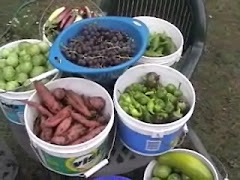 We plant over 30 "winter" salad greens, as we seem to be salad addicts, early in the spring all the way into October for greens to eat throughout the winter. Some of the greens we plant for winter fodder only last into December while others make it through until spring and provide us with fresh food 365 days a year. The Swiss chard and Russian kale in the pictures were planted in the spring and will be eaten throughout the winter.
We plant over 30 "winter" salad greens, as we seem to be salad addicts, early in the spring all the way into October for greens to eat throughout the winter. Some of the greens we plant for winter fodder only last into December while others make it through until spring and provide us with fresh food 365 days a year. The Swiss chard and Russian kale in the pictures were planted in the spring and will be eaten throughout the winter.Cold frames and row covers are used to protect the greens from the weather. They will freeze solid in the depths of winter but as long as they are protected from the elements they will do fine. Frequently we pick totally
 frozen salads in the winter and allow them to slowly thaw in a cool room before preparing... you honestly cannot tell the difference between mustard, kale, spinach, mache and a few others that have been thawed out from their fresh summer counterparts. Actually there is a difference in the brassicas, they taste much sweeter in the cold months.
frozen salads in the winter and allow them to slowly thaw in a cool room before preparing... you honestly cannot tell the difference between mustard, kale, spinach, mache and a few others that have been thawed out from their fresh summer counterparts. Actually there is a difference in the brassicas, they taste much sweeter in the cold months. 
Timing is everything though, some chard and kale get planted in spring so that they will have a stronger root system and provide bigger greens in March, April, and May when they come out of hibernation and some are planted in the late summer and early fall because the smaller leaves seem to withstand the cold much better. Big Swiss chard leaves will always turn to mush on us after a couple of heavy freeze and thaw cycles but the smaller chard leaves are much more hardy. Winter spinach, mache, mustard, turnip greens and chicory are always planted in the fall so that they will not go to seed before the cold sets in. Our garden is around 9-10,000 square feet and about 2,000 of that is used exclusively for winter greens.























No comments:
Post a Comment